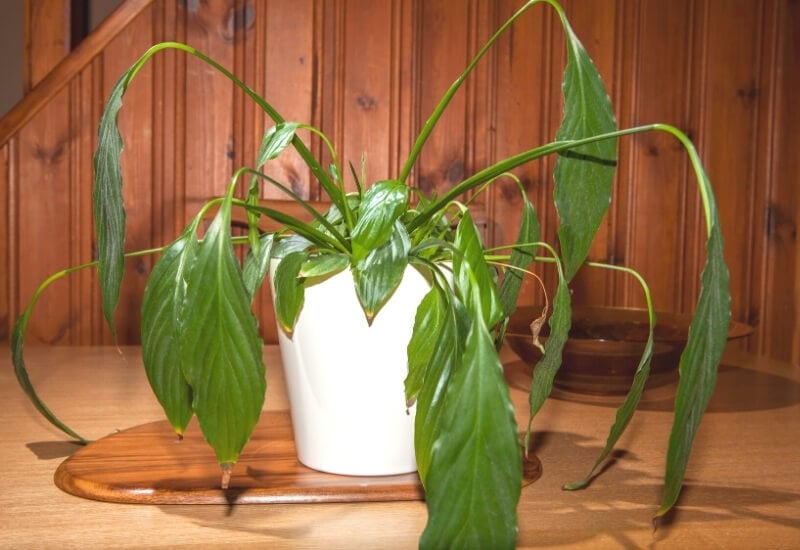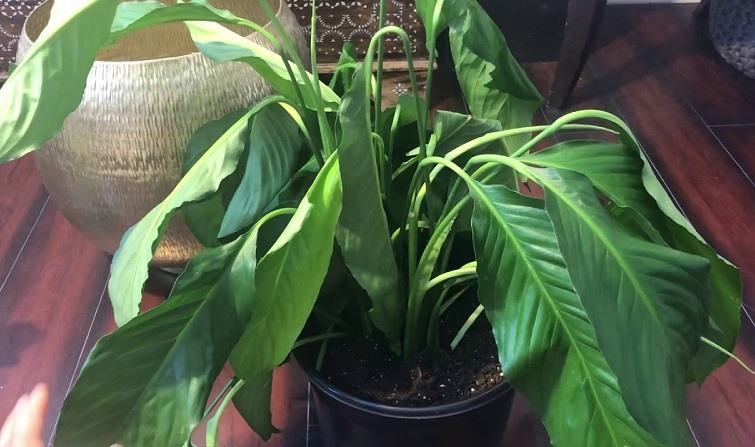The peace lily is a tropical evergreen plant native to Central and South America. The tropical plant can thrive outside its native environment only by providing similar growing conditions. Otherwise, this flowering plant will become droopy if you do not replicate its growing conditions.
So, why is my peace lily drooping? Overwatering and under-watering are the leading causes of a drooping peace lily plant. Other possible causes are direct sunlight exposure, extreme temperatures, insect infestations, low humidity, diseases, and poor soil condition.
We recommend not panicking since peace lily drooping is common and manageable. The golden rule is learning to find the exact cause and fix it. Keep reading this article to figure out the reasons for peace lily drooping and tips for bringing the plant back on track.

Reasons for Peace Lily Drooping
Peace lilies are beginner-friendly houseplants due to their ease of care and maintenance. Drooping peace lilies can occur due to numerous conditions. We recommend investigating your houseplant to determine the root cause and fix it.
How quickly you react to the drooping peace lily will determine its recovery period. But there is no need to freak since peace lily drooping is a manageable problem. Below are the most common reasons for peace lily drooping and their respective fixing tips: (Source: University of Vermont).
Overwatering Problem
Overwatering is the leading cause of a droopy peace lily plant. It occurs due to poor soil drainage and a lack of drainage holes at the bottom of the container. The problem results in waterlogged soil that inhibits the peace lily roots from breathing and absorbing nutrients.
The signs of overwatering in peace lilies are characterized by drooping leaves, leaves turning yellow, dark brown spots on the stalks, and brown edges and tips of leaves. Overwatering is a dangerous practice for all houseplants and not only peace lilies.
We recommend using a well-draining soil and container with drainage holes at the bottom to get rid of excess water. Besides that, remember to inspect the soil moisture content before watering your peace lilies.
Under-watering Issue
Inconsistent watering habit is another underrated cause of a drooping peace lily. The peace lilies have herbaceous stems that require sufficient water to maintain an upright posture. Lack of water will make your peace lilies stem dehydrate and start to droop.
Peace lily leaves drooping is a sign that it is time to water the plant. If the drought condition persists, the leaves will start to hang and fall off the plant. We recommend pruning the affected leaves to help revive your peace lily.
Fixing a drooping peace lily plant due to under-watering is easier than the overwatering counterpart. Schedule a strict watering routine to keep your houseplant hydrated and healthy throughout the year.
Peace lilies require more watering during the spring and summer seasons due to active growth. I recommend reducing the watering frequency during the fall and winter seasons because of the dormancy effect.
Direct Sunlight Exposure
Peace lilies are native to the Central and South American tropical rainforests since they grow under the canopy and can survive in a low-light environment. The tropical plant can tolerate fewer hours of direct sunlight in cooler climates.
But prolonged exposure to direct sunlight will result in scorch leaves that will become dry and develop brown patches. Increased heat and light exposure are the reasons for the drooping peace lily leaves. The phenomenon occurs due to more water loss than absorption rate.
We recommend moving the plant away from the spot that receives direct sunlight. Choose an indoor location that receives bright indirect sunlight to prevent a drooping problem. Be sure to provide ultimate care to foster healthy growth.
Pest Infestations
Peace lilies are vulnerable to mealybugs since these insects love to feed and live on the plant. If these bugs are unattended, they might cause extensive damage to your peace lilies. These pests are known for attacking the stems and leaves by literally sucking the cell sap.
The peace lily will become dehydrated and droopy due to excessive cell sap drain. We recommend inspecting your houseplant while watering for any signs of pest infestations.
Mealybugs appear as fluffy tufts of whites on the stems and leaves. These insects live in colonies, and it can be a daunting experience to deal with them. We recommend cleaning the houseplant with alcohol to remove the bugs.
Remember to isolate the plant from other houseplants to avoid spreading. Another best option for removing mealybugs from peace lilies is spraying them with an insecticidal soap solution. Be sure to read this guide on how to get rid of mealybugs from houseplants naturally.
Extreme Temperatures
Peace lilies prefer an average room temperature to thrive and stay healthy. We recommend keeping your peace lily in a room with a temperature range of 65-75oF (18-24oC). But the indoor temperature is vulnerable to fluctuation.
Any temperature above 80oF and below 55oF will damage your peace lilies. Keep your houseplant away from the heat vents and cold draft to avoid the drooping problem. Be sure to carry out other investigations about the cause of drooping.
Poor Soil Drainage
Growing and caring for peace lilies is a no-brainer since these tropical evergreen plants are not fussy. These plants thrive in fertile and well-draining soil. If the soil does not drain well, it will become waterlogged, and peace lily will respond to the discomfort.
Drooping leaves on peace lilies is the prominent sign of root rot caused by soggy soil due to suffocation and invasion of fungal growth. The damaged roots cannot absorb water and nutrients from the soil leading to the drooping effect.
Peace lilies do not thrive in clay soil since it slows down draining water and creates an environment unsuitable for the roots. On the other hand, sandy soil drains water quickly, which doesn’t provide adequate time for the roots to absorb dissolved nutrients.
If you suspect the soil condition is causing your peace lily to droopy, consider re-potting fresh and well-draining soil. We recommend mixing the potting soil with perlite, peat moss, and fine bark to improve its drainage system.
Lack of Humidity
Peace lilies prefer warm and humid conditions to thrive well. But the indoor humidity is vulnerable to fluctuations due to several reasons. Low humidity is characterized by dry air that may make your peace lily start drooping.
Other signs of low indoor humidity are brown leaf tips, yellowing leaves, and crispy foliages. I recommend increasing the humidity level to rectify the problem. Be sure to allow adequate air circulation to prevent pest infestation, and fungal growth.
Install an electric humidifier to boost your indoor humidity rather than misting the peace lily leaves with water. My favorite method is grouping the houseplants to increase the humidity level around them.
Plant Diseases
Peace lilies are vulnerable to Cylindrocladium root rot that cause drooping and foliage color change. The plant disease is common during the summer since the peace lily demands more water.
We recommend investigating the root system for root-rot signs and trimming the affected ones before spraying with fungicide. Be sure to re-pot the houseplant to fresh potting soil and container to bring it back on track.

Conclusion
If you have read up to this point, we can assume that you have been dealing with a drooping peace lily plant. Before you choose any course of action, we recommend inspecting your plant to identify the exact cause and fix it.
Peace lilies are easy-growing tropical flowering plants that can easily be brought back on track in case of a problem. Peace lily drooping may be due to inappropriate watering, temperature stress, too much direct sunlight, and many other factors.
We hope the information above will help you identify the causes of peace lily leaves drooping and appropriate measures to implement. Feel free to share the information with your friends or family members about growing peace lilies.
Readers Who Read This Also Read:
